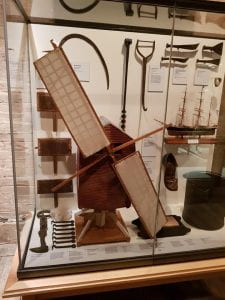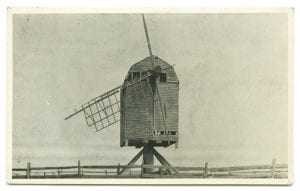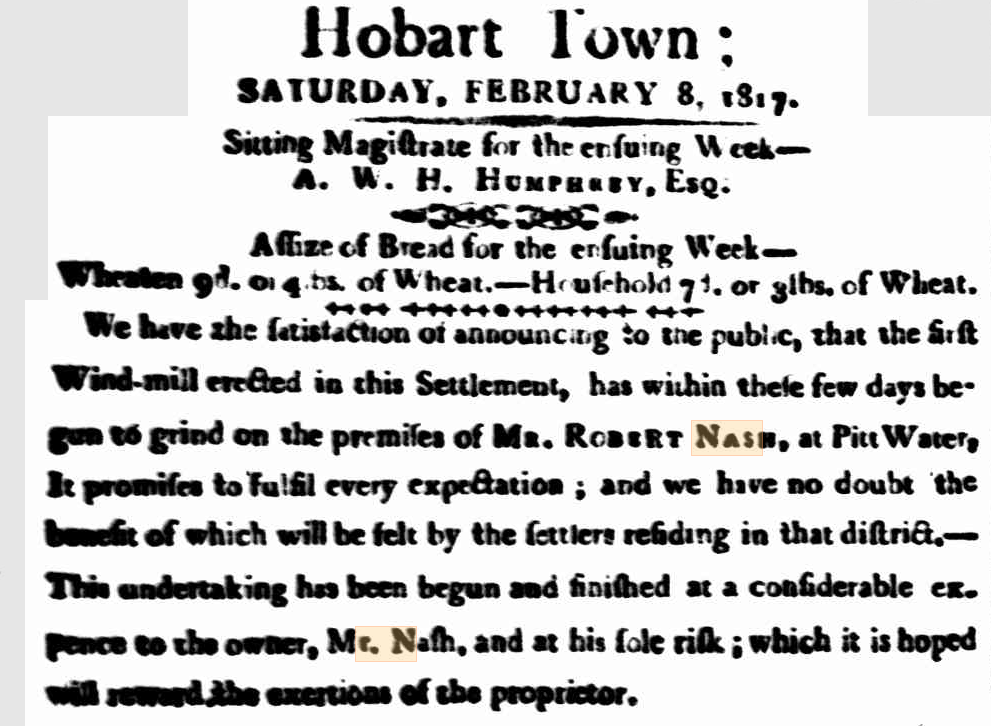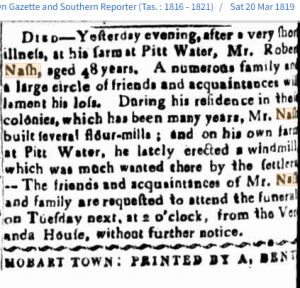If you were living in the Pitt Water area of the district of Richmond around 1815, you would have seen a windmill. Is this an image of Robert Nash’s original windmill or another built later in the century or maybe his original mill was removed and rebuilt after his death?
Robert Nash was the son of a millwright and born at Edenbridge in Kent, England in 1771. (There is some discussion about this – see Jill Watson comment below) But at age 19 he stole some boots and shoes and was sent out to New South Wales in 1791 on the Albemarle as a convict. Before being sent to Norfolk Island, he married Ann Hannaway, who was also a convict from the Second Fleet. Ann already had three children and bore Robert four daughters while on Norfolk Island. Nash was very well behaved on the island, received a grant of land and an absolute pardon in 1800.
In 1808, Robert Nash and his family was one of many who departed Norfolk Island to settle in Hobart Town. Again he was given a grant of 10 acres near the New Town Rivulet where he built his first flour mill. This unfortunately was swept away in floods in 1809. In 1810 he built a second mill, this time on the Hobart Rivulet. More land was granted as the colony needed more wheat for its growing population. He received 200 acres near Pitt Water. He built a mill at his own expense in 1815. His land was south of the present day school and bounded by Sorell and Pittwater Rivulets.
By 1817 he was supplying the Hobart Town commissariat as one of its largest contractors. Robert also put an ad in the Hobart Town Gazette warning people who lit a fire in his paddocks to summon the ferry at Pitt Water to refrain from doing so until the end of the harvest.
Robert’s health suffered with all this hard work in the early colony and he died in 1819 at age 48.
Did his windmill survive? Or was it sold after his death to pay his debts. Edward Lord and James Lord were the principal creditors of Robert Nash’s estate. The windmill was still standing in February 1820 when Robert’s property went under the hammer at auction.
Robert’s mill in Liverpool Street, Hobart called the Old Mill was still in operation in June 1821 when Mr J A Motton opened it. It was owned by Walter Crammond. Cost for grinding was one shilling and threepence per bushel or 8lbs of wheat. The mill and acreage around it was again sold in 1824.
Update to this post:
Since mentioning this post on the Sorell Historical Society Facebook page, Karina Looby nee Newitt has added a photo of a replica of Nash’s Mill which can now be found in the Tasmanian Museum and Art Gallery TMAG. The replica was built by her father Alan Newitt, who had lived in the Blue Bell Inn.

Sources: Much of the early information was found in Robert Nash’s biography. Information about flour milling found in this thematic study.
Windmill images courtesy of Tasmanian Archives and Heritage Office, George Billing Collector – Windmill at Sorell –NS479/1/41 and NS479/1/42
Clicking on a blue link or image will open to the digitized document or book.
Readers: What do you know about the Nash family and flour milling in the district?





Very sad that my ancestor who was a partner in building all those mentioned mills has been left out! (That’s selected history for you!!)
William Hambley❤️
Hi Carolyn,
Just did some more checking and yes, William Hambley and John Duncombe were one part and Robert Nash another part when building the mill that is in Hobart. I found the information on Irene Schaffer’s website
There has been discussion about Sorell mills for many years. It now seems that there were two windmills, or even one which was moved. Nash’s mill was situated on the southern side of what is now the Tasman Highway – on the point near Nichols factory. Later on Downward built his mill in the middle of The Circle where there is now a nursing home. There is some suggestion that he recovered the remains of Nash’s, by then, abandoned mill. Alan Newitt’s model is of Downward’s mill. During my time in Sorell I spent many pleasant hours discussing family and local history with him. The model was a precursor to the reconstruction of the mill in its original position as a tourist attraction. Why this never happened is another story.
“Why this never happened is another story.” Any chance you could elaborate in this a bit more? Am curious to know why it never went any further… Thanks!
I would like to correct the belief that Robert Nash was born at Edenbridge, Kent, son of a millwright. This is derived from Nash descendant, Roy Bridges’ 1948 book, ‘That Yesterday was Home’, where he says “My mother, telling Gran’s stories to us when we were children, did not know where in Kent, and I have no other notion than Edenbridge…I care to fancy that this village in Kent, as I saw it green and golden in June, was the home of the boy Robert Nash.”
A family Bible belonging to the Reardons (Nash’s daughter, Elizabeth married Bartholomew Reardon), lists Robert Nash’s birthdate as 17 July, 1771, which corresponds exactly to the baptism record of a Robert Nash (b. 17 July, baptised 4 August, 1771) at St Mary Magdalen, Bermondsey, son of Robert Nash, a cooper by trade, and Susanna Sarah Grey, who lived in “Courtyard”, Bermondsey, Surrey. This puts Nash much closer to the scene of his London crime, than some small village in the middle of Kent.
In early May 1821, a windmill the spitting image of Stanfield’s post mill arrived in Sydney. I believe it was built by Robert Nash and it was probably the one that went to auction after Nash’s death. Sydney’s only individual making windmills, Nathaniel Lucas, suicided in 1818 or 1819 and English millwright John Smith arrived in Sydney in 1822. Nash’s windmill lasted in Sydney for roughly 22 years and could have found a new home in the mid-1840s outside of Sydney. Do you have anything on what Nash’s post mill was used for in Hobart prior to May 1821. RON MADDEN
ROBERT NASH’S two windmills of 1816????? Robert Nash was building two identical windmills in June 1816, one for Daniel Stanfield and one for himself. He finished the windmill for Daniel Stanfield in 1816 ie the Rokeby post mill, and his own in February 1817. Nash died in 1819 and his post mill was put up for auction in March 1820. James and Edward Lord were major creditors to Nash’s estate and the Nash’s post mill arrived in Sydney in early May 1821 but where was it from February 1817 to March 1820 – Sorell perhaps??????. If Nash family members have any further knowledge, I would very be pleased to hear from them. Stanfield’s Rokeby post mill was blown over in 1906 at Rokeby. There is stylised painting that shows Nash’s windmill in Sydney in 1843 on Miller’s Point. Ron Madden
ROBERT NASH’S IDENTICAL POST MILLS WERE BUILT AT ROKEBY IN 1816 AND PITT WATER IN EARLY FEBRUARY 1817. sORELL IS OFF THE HOOK.
RON MADDEN
Hi Ron,
Pittwater is the name of the area before it formerly became the town of Sorell in 1820.